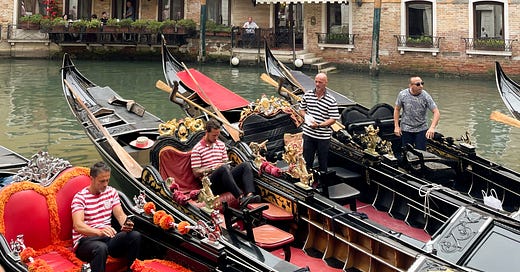Three days in Venice, Italy
Sipping on spritzes, seeing the opera, and visiting the glass island of Murano
Venice is one of those places that you’ve seen so many pictures of to the point that they don’t really take your breath away anymore. But seeing Venice in person really did for me. I expected to like it... I didn’t expect to love it. It has the romantic charm of Florence with the east-meets-west cultural richness of Istanbul. Add on a backdrop of ancient waterways—my eyes were wide in wonder for all of three days. The architecture and the history of the city were beyond my imagination. And unlike a lot of coastal Italian destinations, Venice isn’t just a one-season town—it has the heartbeat of a working city where citizens live year-round.
Everyone might be to go to Ischia or Puglia (myself included) over the “tourist traps” these days, but Venice was a good reminder that touristy destinations become touristy because they are so special to begin with.
The city wasn’t teeming with as many people as I’d thought there would be, and I’ve since learned that there actually are far fewer visitors to Venice now than there were pre-pandemic. (Venice banned cruise ships in 2021 and added a tourist tax for day trippers, who make up four-fifths of Venice tourists.) While it was busy, the crowds were on par with destinations like Positano or Santorini. We were able to make last-minute restaurant bookings fairly easily, which these days, you can’t even do in Denver—it’s such a breath of fresh air to make a same-day reservation on holiday.
I found Venetians to be warm and welcoming, and service was top-notch everywhere. Prices for dining, shopping, and lodging felt very reasonable, too. The one thing I’ll note is that Venice was somewhat difficult to navigate—between the many unmarked alleys and the spotty cell reception, Google Maps doesn’t work particularly well there. We got lost ourselves quite a few times, but unless we were in a rush to get to a reservation, we didn’t really mind finding ourselves in random corners of the city. After we started using a paper map, things got exponentially easier!
We’d originally booked two nights in Venice, intending to overnight in Verona or Lake Garda on our drive to our next stop in Piedmont—but by the end of our first day, we knew we needed more time and marched ourselves to the lobby and added another night to our stay.
While I rarely hear anyone talk about the food and drink in Venice, we didn’t have a disappointing meal. We were pleasantly surprised that every time we ordered a pasta to share, restaurants actually split it into two servings for us. One of the most dangerous things about northern Italy is how much bread they gave us everywhere… especially because it’s typically served hot and crusty, and often with breadsticks.






